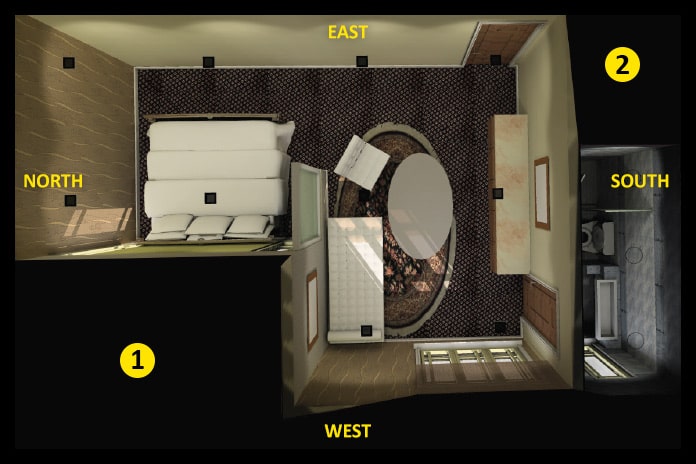
When we move into a new home, one of the questions we ponder about is the selection of which bedroom to give to each family member. While selecting may sound easy, it can also be one of the more important decisions made, as it directly affects the luck of each family member.
 So how do we begin in the selection process? First, we need to study the general floor plan to identify which bedrooms belong to East group and which to West group. Once we have segregated the rooms into East and West, we then match each family member’s Kua number to their room groups. East group individuals should sleep in rooms located in the East group sectors (East, Southeast, South or North) and West group individuals should sleep in rooms located in West group sectors (Southwest, Northwest, Northeast and West).
So how do we begin in the selection process? First, we need to study the general floor plan to identify which bedrooms belong to East group and which to West group. Once we have segregated the rooms into East and West, we then match each family member’s Kua number to their room groups. East group individuals should sleep in rooms located in the East group sectors (East, Southeast, South or North) and West group individuals should sleep in rooms located in West group sectors (Southwest, Northwest, Northeast and West).
While it is ideal to select a room that is in the same East or West group as your Kua, we usually find ourselves in the situation where we have to settle with a room that is not in the same group category as our Kua number. When this is the case, we have to look at a few factors to decide which room is most suitable.
For example, if you are a West group person and having to choose rooms located in the East sectors, first look for the room that is firstly NOT in your total loss sector, then try to find a room that is the least inauspicious for you based on your inauspicious directions.
Next, study the shape and orientation of the room to see whether the room is suitable for you to tap your auspicious directions. With most bedrooms, we only have 1 or 2 walls to choose from due to the location of the wardrobes, windows and doors. In most cases, the bed location is predetermined through the location of the power points and the bed location in relation to the windows and doors. So we have to make sure that the bed direction is one that is suitable for you.
The next step is to be aware of your surroundings and to identify whether there are any elements that pose a threat to your sleeping position, such as wall edges, direct line of sight of the doors, and whether your bed is positioned such that it forces you to sleep with a toilet behind you. In some cases, we have to strike a fine balance of the good and the bad, and settle for a bed position that takes into account all the negatives to find a positive solution.
Design Solution 1

In the example here, we are faced with a situation whereby the room is located in the South corner of the home, thereby ideal for all East group persons. However, the only wall that is ideal for the residents is the West wall which coincidently is the person’s total loss direction. In such a case, we have to look for alternative directions to locate the bed.
When we consider the constraints of the bedroom space, the North and South walls do not seem ideal, as the North wall results in the bed being cramped into a corner, causing a major shift in the overall room orientation. This can result in a claustrophobic effect. By having the bed along the South wall, it causes the bed to not only be cramped to a corner, but also positioned such that it sits in between wall and window, which would create more problems than it would solve.
Therefore, through elimination of directions, the most ‘ideal’ direction in this case would be the East wall, which would allow the bed to center itself to the main orientation of the room. The downside is that the door to the room would directly face the bed, so a partition screen would be needed to divert the direct line of sight, which then allows the bed to sit within the room properly and also to create a small entry foyer to divert the flow of movement.

The other aspect is that the bed headboard would be sharing the same wall as the toilet. To avoid this, a physical partition backdrop is introduced to create a physical barrier with the toilet wall, but also to create a backdrop that reinforces the bed position to the overall room shape and orientation.
Design Solution 2

In a second situation, we are faced with an odd-shaped room situated in the West corner of the house. With the resident being a West group person, it also means there is only one direction for us to position the bed. So to find the solution, we first must identify the issues of the room. In the main section of the room, the doors are placed such that they would be in direct line of sight of the bed and cramped in a corner. Also due to the odd shape of the room, it creates a sharp edge that directly faces the entrance door, thus creating an invisible poison arrow to anyone that enters the room.

To resolve this situation, a partition screen is needed, to serve a dual purpose. First, it allows the corner edge to disappear, and second, it allows the room to be divided into two regular shaped rooms. This allows the main area to act as the bedroom living, where all the entertainment and reading would be done, and the smaller area can then serve as the main sleeping quarters. This creates a more intimate scenario where we allow the bed to be positioned to face the West direction, but also create a niche sector to separate the room in two parts, differentiating between the yin and yang activities of the bedroom.
Finally, the other aspect to take into consideration is the Flying Star combination in the room. Based on the facing direction of the house, we are able to extract the Flying Star combinations of the sector, and from there, we can identify what elements would be ideal to control or to enhance the room. Through the different elements of your design palette, we can introduce any element into the room through the use of flooring materials, wall colours and ID decorative features, thereby creating an aesthetic feel that not only suits our design intent but also becoming a feng shui cure in itself.
























